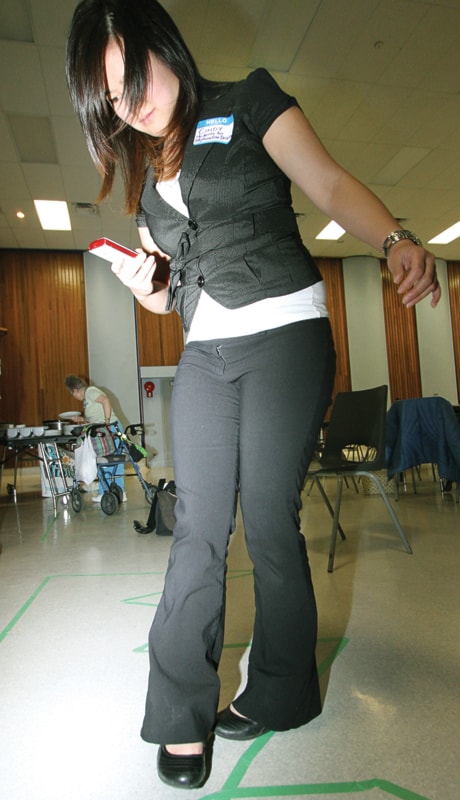Teaching students about the danger of texting while driving is just a matter of putting one foot in front of the other.
Students for Cellphone-Free Driving ask students to walk a crooked line and compare it to how difficult it is to walk the same line while texting a simple sentence.
Cindy Du, project co-ordinator with Students for Cellphone-Free Driving, said students quickly discover that it takes twice as long — or longer. They wobble and misstep.
“Their texting isn’t very good either,” Du said in Red Deer at a Safe Communities Central Alberta luncheon this week.
“If you can’t even walk and text, what makes you think you can drive and text? Driving is a more complex task,” said the University of Alberta medical student who will spend the summer teaching teens about the hazards of using a cellphone while driving.
Last year, about 3,000 Edmonton students saw a Students for Cellphone-Free Driving presentation. This year, high school students across the province will participate as part of Career and Life Management class, including Red Deer students.
Information booths will also be set up at community festivals and in malls.
Cate Burant-Ferniuk, communications officer with the Coalition for Cellphone-Free Driving, said in the five seconds it takes to text a message, a driver can travel the length of a football field.
People are 23 times more likely to be involved in a collision if they’re texting. If they’re talking on the phone, a collision is four times more likely, and using a hands-free phone is no better because it’s the conversation that’s distracting, Burant-Ferniuk said.
Research shows young women are the worst offenders when it comes to talking on the cellphone while driving, she said.
“They talk longer and they talk more often,” Burant-Ferniuk said.
A 20-year-old from Blackfalds, who didn’t want her name used, looked confused when asked how often she shuts her cellphone off.
“Off. I’ve never had it off,” the young woman said with a laugh. “I just put it on vibrate. I use it as my alarm clock.”
“It has games. Internet. You can call people. You can text. There’s just so much you can do with a phone.”
She said cellphones are convenient. They’re good for emergencies. Her cellphone has replaced her home computer and she has about 400 phone numbers stored on her phone.
While she prefers to talk on the phone, she also uses text messaging — at times behind the wheel.
“It’s hard sometimes because you start swerving into the other lane. (People) probably shouldn’t be texting but everyone talks on the phone while they’re driving. It’s not that big a deal.”
In Alberta, 25,000 collisions each year involve driver distraction.
Transport Canada says at least 20 per cent of collisions are due to driver distraction.
Red Deer RCMP Cpl. Gordon Baker, a collision analyst, said proving that cellphone use caused a collision can be difficult.
His last investigation proven to involve a cellphone was about two years ago when the driver T-boned another vehicle after speeding through a stop sign in rural Alberta in broad daylight. The crash caused serious injury.
The driver blasted past three or four indicators, like a sign warning drivers to prepare to stop and an intersection sign.
“For 300 metres, this particular driver didn’t slow down one iota, went over five sets of rumble strips,” Baker said.
People don’t usually tell police that they were using a cellphone, but this time the driver admitted it. Sometimes it comes out when people call police in a panic after hearing a crash and lose connection while talking to the driver, said the RCMP officer, who attends collisions throughout Central Alberta.
Unfortunately, people believe they need to be in touch with others at all times and driving is seen as an unproductive task, he said.
“People are trying to accomplish more in less time. If they walked a mile in my shoes, they’d see things differently.”
He has reconstructed about 400 collisions and not one was due to mechanical failure, only one was caused by the environment and one was unavoidable. It comes down to driver error, Baker said.
In the fall, the Alberta MLAs will debate legislation to ban the use of hand-held cellphones and activities like texting, reading, writing and personal grooming while driving. The proposed fine is $172 with no demerit points.
Only Alberta and New Brunswick haven’t adopted legislation to ban hand-held cellphones while driving and Quebec is considering changing its legislation to also ban hands-free cellphones while driving.
Students for Cellphone-Free Driving is trying to reach students now before they get into the habit of juggling a cellphone while driving.
For more information, go to www.studentcellphonefreedriving.com
szielinski@www.reddeeradvocate.com
